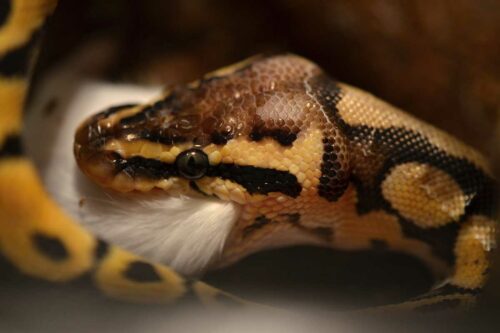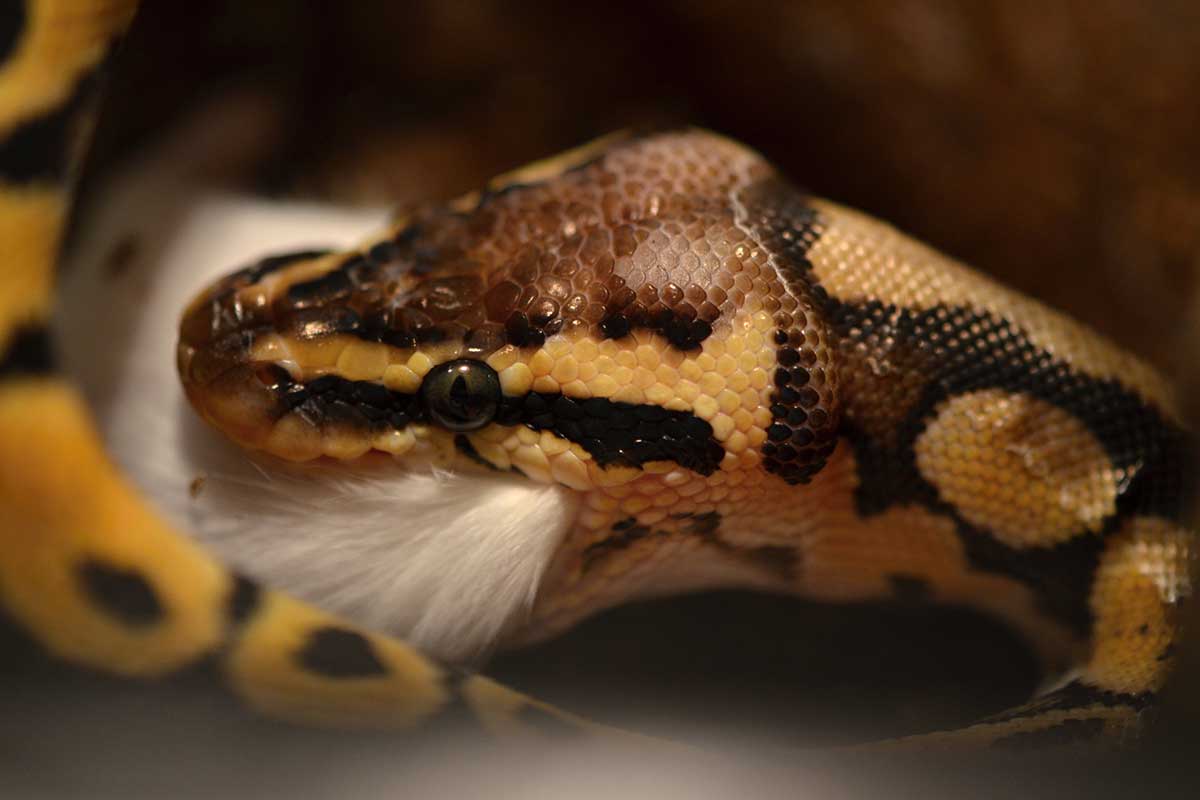New ball python parents often worry that their reptile babies aren’t eating enough. They don’t need much energy to keep them going so eat rarely, even as a fast-growing infant snake.
That’s why it’s so important to know how often you should be feeding your ball python and how much they should be eating at each meal to ensure they’re getting the nutrition they need.
Today, we’ll share tips on when to feed your ball python, what you should be giving them, and how much.

But ball pythons are known to be fussy eaters, so we’ll also talk about why they might not be eating and what you can do to encourage them to eat when necessary.
What Do Ball Pythons Eat In The Wild?
Ball pythons are carnivorous and also opportunistic eaters. In the wild, they will eat pretty much any live prey that is small enough for them.
This mostly includes small mammals, fish, and amphibians, but they will also eat larger insects such as grasshoppers and crickets.
When they catch their prey, ball pythons will grab them with their sharp teeth. They’ll then coil their bodies around the prey and tighten their grip every time the animal exhales. This eventually results in the prey suffocating or suffering from heart failure.
In the wild, ball pythons will feed themselves about once every one to two weeks, though if they come across a tasty morsel of prey, they may still gobble it down even if they have recently eaten. If necessary, they can go a number of months without food.
How Often Should You Feed Your Ball Python?
In captivity, you want to mimic the eating cycle of your python in the wild. This means that a ball python in their prime of life only needs to eat once every seven to 14 days, as long as they’re given a sufficient amount of food for a single sitting.
You should try and choose a prey animal that is about the same width as your python. This is more or less what they need and it won’t represent a choking risk.
Anything much smaller might not be enough and they may need multiple prey items to eat more frequently. But always wait at least three days before offering your ball python more food as it takes them one to two days to fully digest a meal.
Younger ball pythons, up to the age of one year, need to eat more regularly, about every five to seven days. This is because they need additional energy to power their fast growth in the initial months of life.
As your python gets older, they will need to eat less. In the wild, ball pythons only live between two to eight years. But in captivity, they can live up to 30 years.
Once they reach about five years old, they don’t need to eat quite as much. They may only need to eat once every 14 to 30 days, and even less frequently as they get older.
Pythons don’t use much energy to power their standard activity when they are no longer in rapid growth, so they just don’t need to eat that frequently.
Read our guide to the ball python lifespan here.
What Should You Feed Your Ball Python?
Ideally, your python should be eating live prey, as they do in the wild, but this can be a complicated practice. You can’t just catch rodents around the house and the garden as they are often infected with parasites and bacteria that can be harmful to your snake.
In addition, live prey can get nervous when placed in the terrarium with your snake and may bite them. These bites can cause infection.
But if you have access to a reputable breeder who can provide fresh prey and you observe your ball python during feeding, you can still feed them live prey.
Your next best option is recently killed prey, which you’ll need to source from a similar serpent food breeder.
You snake may not immediately take to these as they won’t often eat dead prey in the wild. But you can make the meat more enticing by cutting it open to make it more fragrant.
The most convenient option for most reptile parents is frozen prey. This needs to be thoroughly thawed before giving it to your snake or they won’t find the food enticing and it will certainly cause them an upset stomach.
You’ll also probably need to cut these thawed animals open to give them a more enticing smell (at least, enticing to a snake).
All prey should be sprinkled with a calcium supplement to ensure your python is getting all the calcium they need to thrive. This does not need to be mixed with vitamin D3.
While your snake also needs vitamin D3 in order to make use of dietary calcium, they should get enough of this from basking under their UV lamp. Too much dietary vitamin D3 can flood their system and make it difficult for them to make use of calcium.
Best Prey Animals For Your Ball Python
Variety is the spice of life, and there are a number of accessible prey animals that can be fed to your ball python.
Mice
Mice are an excellent choice, especially for smaller ball pythons, because they are high in protein and low in fat. They have roughly 55% protein, 23% fat. 2.9% calcium, and 578,272 IU/kg of vitamin A.
Rats
Rats offer a similar nutritional balance as mice and are a good size for larger snakes.
They are thought to be the best approximation to what your ball python would eat in the wild. They contain about 59% protein, 23% fat, 2.62% calcium, and 151,389 IU/kg vitamin A.
Chicks
Baby chickens are especially good for young pythons that need extra protein and calcium for development, but again can be too small for fully grown pythons. They contain about 64% protein, 22% fat. 13.69% calcium, and 35,600 IU/kg vitamin A.
Hamsters
Hamsters are high in fat, so they make a good occasional treat rather than a dietary staple. They contain about 49% protein, 34% fat, 2.51% calcium, and 26.666 IU/kg vitamin A.
Crickets
Ball pythons will eat insects in the wild, though it is not their preferred food. But if you can’t get your hands on anything else, crickets can make a good intermediary meal.
They contain about 65% protein, 35% fat, 366 mh/kg of calcium, and <1,000 IU/kg of vitamin A.
Frogs
Ball pythons eat frogs in the wild, so this is something you can give them in captivity too. Frogs contain about 71% protein, 10% fat, 2.49% calcium, and 25,100 IU/kg vitamin A.
Chunks Of Meat
Meat cuts, similar to the ones you eat yourself, can be eaten by your python, but they aren’t as nutritious as full prey because they don’t contain the organs and bones.
Rabbits and minks are the most common choices. Rabbits contain around 75% protein, 13% fat, and 5.93% calcium. Mink contains about 72% protein and 11% fat.
Whatever you give your python, food should be passed to them using a pair of feeding tongues such as these heavy duty stainless steel long tweezers.
What If Your Ball Python Isn’t Eating?
Ball pythons can go three to four months without eating, and they may do that if it’s breeding season. But if your python goes for extended periods rejecting food, it could be a sign of a problem.
Remember that you should never handle your python when they are refusing food because it can create confusion and stress. Even at the best of times, they should only be handled for a maximum of 15 minutes per week.
There are several reasons why your python might decide not to eat.
First and foremost, it can be challenging for them to adjust to a new home. You might just need to wait for them to feel comfortable and familiar with their surroundings.
You can help them along by making sure you’re feeding them the same things they ate in their previous home. This will increase the chances of them recognizing their prey and taking the risk.
If there are issues with their habitat, this is another reason they may reject food. The problem is often that the temperature and humidity levels are not right.
Heat should be set to 75-85 degrees Fahrenheit during the day and 70-75 degrees at night. Ball pythons should also have a basking area at about 90-95 degrees Fahrenheit and cooler shaded areas.
Humidity levels should normally be at 50% but increased to 80% when they are ready to shed. Humidity should be returned to normal within about two days of the completion of shedding.
The size of the terrarium can also be an issue. If the cage is too small, a python will feel trapped and may reject food. If the tank is too large, it can also be a source of stress, at least initially. It could be worth moving them to a smaller space, at least temporarily.
The other main issue could be an illness, such as parasites. You may also notice other changes in their appearance and behavior that seem unusual.
When you can’t identify another reason for their loss of appetite, it’s always a good idea to organize a trip to the vet. If it’s not a disease, it could just be stress and your vet will be able to help you develop a strategy to reduce that underlying cause.
Ball Python Feeding FAQs
How long can a ball python go without eating?
In the wild, a ball python can go for as long as two years without eating a meal! While this is possible, it is not recommended in captivity. If your python goes more than three months without eating, this is a cause for concern.
How do I know if my ball python is hungry?
Ball pythons will display some specific behaviors when they’re feeling hungry.
These include prowling around the front of their tank, being more active and agitated than usual, flicking their tongue more often than usual, and keeping a keen eye on anything that passes close to their tank.
Feeding Your Python
Many new ball python parents are surprised at how little their snake eats. But they don’t need to feed very often to maintain their health. Adults in the prime of life only need to eat every seven to 14 days.
They need to eat a little more often as juveniles in the first year of life to maintain their rapid growth, about once every five to seven days.
In captivity, you ball python might live up to 30 years, while they tend to live one two to eight years in the wild. At around five years of age, they’re already becoming senior and will need to eat less often. This may be as little as every 20-40 days.
The important thing is to feed them the right food in the right amount. This means small prey animals akin to what they eat in the wild, complete with bones and organs, and about the same size as the width of your snake.
Follow this feeding plan, and you and your ball python may be together for many years!
Read our guide to why ball pythons make excellent pets for first time reptile owners and what other reptiles to consider.
- Can Guinea Pigs Eat Potatoes? Foods To Avoid - September 24, 2023
- Can Guinea Pigs Eat Carrots? Feeding Advice - September 23, 2023
- How To Make A DIY Bearded Dragon Enclosure - September 22, 2023

